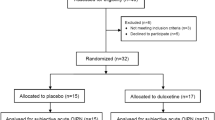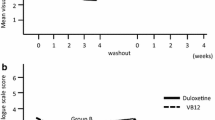Abstract
Background
This open-label pilot study is aimed to evaluate the efficacy and tolerability of the antidepressant duloxetine, which is effective for diabetic neuropathic pain, in the treatment of chronic oxaliplatin-induced peripheral neuropathy (OIPN).
Methods
We enrolled a total of 39 patients with stage III or IV colorectal cancer with chronic OIPN. They were treated with duloxetine by increasing the dose from 30 mg/day to 60 mg/day. Patients’ pain intensity was rated at baseline and 12 weeks after duloxetine administration. The severity of neuropathic pain was evaluated using the visual analog scale (VAS) score and the National Cancer Institute Common Toxicity Criteria for Adverse Events, version 3 (NCI-CTCAE v3.0).
Results
Nine patients (23.1%) discontinued duloxetine before the end of treatment because of adverse events. Of the remaining 30 patients, 19 patients (63.3%) had a VAS score improvement. Among them, nine (47.4%) showed a simultaneous grade improvement, and the other 10 patients (52.6%) had a stable grade according to NCI-CTCAE v3.0. Treatment with duloxetine did not impair renal or liver function and did not interfere with chemotherapy.
Conclusions
Duloxetine is feasible in treating chronic OIPN with tolerable toxicity at a daily dose of 60 mg/day.
Similar content being viewed by others
References
Weitz J, Koch M, Debus J et al (2005) Colorectal cancer. Lancet 365:153–165
Meyerhardt JA, Mayer RJ (2005) Systemic therapy for colorectal cancer. N Engl J Med 352:476–487
Kim GP, Erlichman C (2007) Oxaliplatin in the treatment of colorectal cancer. Expert Opin Drug Metab Toxicol 3:281–294
de Gramont A, Figer A, Seymour M et al (2000) Leucovorin and fluorouracil with or without oxaliplatin as first-line treatment in advanced colorectal cancer. J Clin Oncol 18:2938–2947
Andre T, Boni C, Mounedji-Boudiaf L et al (2004) Oxaliplatin, fluorouracil, and leucovorin as adjuvant treatment for colon cancer. N Engl J Med 350:2343–2351
Cassidy J, Tabernero J, Twelves C et al (2004) XELOX (capecitabine plus oxaliplatin): active first-line therapy for patients with metastatic colorectal cancer. J Clin Oncol 22:2084–2091
Tournigand C, Cervantes A, Figer A et al (2006) OPTIMOX1: a randomized study of FOLFOX4 or FOLFOX7 with oxaliplatin in a stop-and-Go fashion in advanced colorectal cancer—a GERCOR study. J Clin Oncol 24:394–400
Wilson RH, Lehky T, Thomas RR et al (2002) Acute oxaliplatin-induced peripheral nerve hyperexcitability. J Clin Oncol 20:1767–1774
Extra JM, Marty M, Brienza S et al (1998) Pharmacokinetics and safety profile of oxaliplatin. Semin Oncol 25:13–22
Grothey A (2003) Oxaliplatin-safety profile: neurotoxicity. Semin Oncol 30:5–13
Saif MW, Reardon J (2005) Management of oxaliplatin-induced peripheral neuropathy. Ther Clin Risk Manag 1:249–258
Wolf S, Barton D, Kottschade L et al (2008) Chemotherapy-induced peripheral neuropathy: prevention and treatment strategies. Eur J Cancer 44:1507–1515
Cathomas R, Koberle D, Ruhstaller T et al (2010) Heated (37 degrees C) oxaliplatin infusion in combination with capecitabine for metastatic colorectal carcinoma: can it reduce neuropathy? Support Care Cancer 18:1263–1270
Detke MJ, Lu Y, Goldstein DJ et al (2002) Duloxetine, 60 mg once daily, for major depressive disorder: a randomized double-blind placebo-controlled trial. J Clin Psychiatry 63:308–315
Goldstein DJ, Mallinckrodt C, Lu Y et al (2002) Duloxetine in the treatment of major depressive disorder: a double-blind clinical trial. J Clin Psychiatry 63:225–231
Goldstein DJ, Lu Y, Detke MJ et al (2004) Duloxetine in the treatment of depression: a double-blind placebo-controlled comparison with paroxetine. J Clin Psychopharmacol 24:389–399
Goldstein DJ, Lu Y, Detke MJ et al (2005) Duloxetine vs. placebo in patients with painful diabetic neuropathy. Pain 116:109–118
Wernicke JF, Pritchett YL, D’Souza DN et al (2006) A randomized controlled trial of duloxetine in diabetic peripheral neuropathic pain. Neurology 67:1411–1420
Raskin J, Pritchett YL, Wang F et al (2005) A double-blind, randomized multicenter trial comparing duloxetine with placebo in the management of diabetic peripheral neuropathic pain. Pain Med 6:346–356
Price DD, McGrath PA, Rafii A et al (1983) The validation of visual analogue scales as ratio scale measures for chronic and experimental pain. Pain 17:45–56
Aun C, Lam YM, Collett B (1986) Evaluation of the use of visual analogue scale in Chinese patients. Pain 25:215–221
Trotti A, Colevas AD, Setser A et al (2003) CTCAE v3.0: development of a comprehensive grading system for the adverse effects of cancer treatment. Semin Radiat Oncol 13:176–181
Greene FL (2002) The American Joint Committee on Cancer: updating the strategies in cancer staging. Bull Am Coll Surg 87:13–15
Metzger U (1990) Adjuvant therapy for colon and rectal cancer. NIH Consensus Development Conference. Eur J Cancer 26:753–755
Benson AB 3rd, Schrag D, Somerfield MR et al (2004) American Society of Clinical Oncology recommendations on adjuvant chemotherapy for stage II colon cancer. J Clin Oncol 22:3408–3419
Kuebler JP, Wieand HS, O’Connell MJ et al (2007) Oxaliplatin combined with weekly bolus fluorouracil and leucovorin as surgical adjuvant chemotherapy for stage II and III colon cancer: results from NSABP C-07. J Clin Oncol 25:2198–2204
Tesfaye S (2009) Advances in the management of diabetic peripheral neuropathy. Curr Opin Support Palliat Care 3:136–143
Grolleau F, Gamelin L, Boisdron-Celle M et al (2001) A possible explanation for a neurotoxic effect of the anticancer agent oxaliplatin on neuronal voltage-gated sodium channels. J Neurophysiol 85:2293–2297
Ta LE, Espeset L, Podratz J et al (2006) Neurotoxicity of oxaliplatin and cisplatin for dorsal root ganglion neurons correlates with platinum-DNA binding. Neurotoxicology 27:992–1002
Schmeichel AM, Schmelzer JD, Low PA (2003) Oxidative injury and apoptosis of dorsal root ganglion neurons in chronic experimental diabetic neuropathy. Diabetes 52:165–171
Willis WD, Coggeshall RE (1991) Sensory mechanisms of the spinal cord. Plenum, New York
Basbaum AI, Fields HL (1984) Endogenous pain control systems: brainstem spinal pathways and endorphin circuitry. Annu Rev Neurosci 7:309–338
Suzuki R, Rygh LJ, Dickenson AH (2004) Bad news from the brain: descending 5-HT pathways that control spinal pain processing. Trends Pharmacol Sci 25:613–617
Coderre TJ, Katz J (1997) Peripheral and central hyperexcitability: differential signs and symptoms in persistent pain. Behav Brain Sci 20:404–419, discussion 435–513
Ren K, Dubner R (2002) Descending modulation in persistent pain: an update. Pain 100:1–6
Iyengar S, Webster AA, Hemrick-Luecke SK et al (2004) Efficacy of duloxetine, a potent and balanced serotonin-norepinephrine reuptake inhibitor in persistent pain models in rats. J Pharmacol Exp Ther 311:576–584
Stahl SM, Grady MM, Moret C et al (2005) SNRIs: their pharmacology, clinical efficacy, and tolerability in comparison with other classes of antidepressants. CNS Spectr 10:732–747
Rowbotham MC, Goli V, Kunz NR et al (2004) Venlafaxine extended release in the treatment of painful diabetic neuropathy: a double-blind, placebo-controlled study. Pain 110:697–706
Bymaster FP, Dreshfield-Ahmad LJ, Threlkeld PG et al (2001) Comparative affinity of duloxetine and venlafaxine for serotonin and norepinephrine transporters in vitro and in vivo, human serotonin receptor subtypes, and other neuronal receptors. Neuropsychopharmacology 25:871–880
Brannan SK, Mallinckrodt CH, Brown EB et al (2005) Duloxetine 60 mg once-daily in the treatment of painful physical symptoms in patients with major depressive disorder. J Psychiatr Res 39:43–53
** Y, Desta Z, Stearns V et al (2005) CYP2D6 genotype, antidepressant use, and tamoxifen metabolism during adjuvant breast cancer treatment. J Natl Cancer Inst 97:30–39
Bosch TM, Meijerman I, Beijnen JH et al (2006) Genetic polymorphisms of drug-metabolising enzymes and drug transporters in the chemotherapeutic treatment of cancer. Clin Pharmacokinet 45:253–285
Hewes JC, Riddy D, Morris RW et al (2006) A prospective study of isolated human hepatocyte function following liver resection for colorectal liver metastases: the effects of prior exposure to chemotherapy. J Hepatol 45:263–270
Masek V, Anzenbacherova E, Machova M et al (2009) Interaction of antitumor platinum complexes with human liver microsomal cytochromes P450. Anticancer Drugs 20:305–311
Hanioka N, Ozawa S, **no H et al (2002) Interaction of irinotecan (CPT-11) and its active metabolite 7-ethyl-10-hydroxycamptothecin (SN-38) with human cytochrome P450 enzymes. Drug Metab Dispos 30:391–396
Park JY, Kim KA (2003) Inhibitory effect of 5-fluorouracil on human cytochrome P(450) isoforms in human liver microsomes. Eur J Clin Pharmacol 59:407–409
Acknowledgements
This study was supported in part by grants from the Taiwan Clinical Oncology Research Foundation.
Disclosures
The authors declare no conflicts of interest.
Author information
Authors and Affiliations
Corresponding authors
Additional information
Chung-Jen Teng and Hao-Wei Teng have equal contribution.
Rights and permissions
About this article
Cite this article
Yang, YH., Lin, JK., Chen, WS. et al. Duloxetine improves oxaliplatin-induced neuropathy in patients with colorectal cancer: an open-label pilot study. Support Care Cancer 20, 1491–1497 (2012). https://doi.org/10.1007/s00520-011-1237-2
Received:
Accepted:
Published:
Issue Date:
DOI: https://doi.org/10.1007/s00520-011-1237-2




